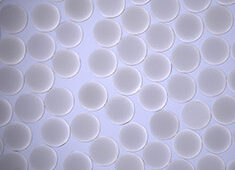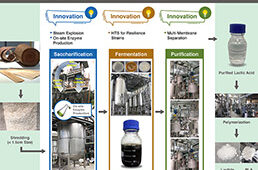Layers of zinc oxide seen through an electronic microscope, on the left: natural pyramid structure, on the right: structure when grown on a mould (height of images 5 microns). |
Do better with less. That is the challenge the researchers
of the Swiss Federal Institute of Technology in Lausanne (EPFL) have set for
themselves, supported by the Swiss National Science Foundation and the Federal
Office of Energy. Their specialty: manufacturing solar cells that are one
thousand times thinner than conventional cells. In order to boost the output of
the cells, they have developed a new nanopatterning technique.
Even though silicon is one of the most abundant elements,
the energy required to make silicon from sand is immense. It is for this
reason, but also to reduce manufacturing costs, that Professor Christophe
Ballif and his team from the Photovoltaics and Thin-Film Electronics Laboratory
at the EPFL have been working for several years on thin-film silicon solar
cells that are a thousand times thinner than conventional cells.
There’s just one catch: the thinner the cells, the less they
absorb the rays of the sun and the less electricity they produce. So
researchers are trying to trap light in the thin silicon layers to increase
their absorption. Traditionally, thin layers of zinc oxide—a material that is
very abundant, completely non-toxic, and that grows in the form of small
pyramid-shaped crystals—are used for this purpose. These crystals scatter light
efficiently into the underlying silicon layer. With such zinc oxide layers,
even a new world record cell efficiency was achieved.
Reducing
costs
But scientists are attempting to beat this record. “It is difficult
to modify the natural pyramidal shape of these crystals in order to obtain even
better light scattering,” explains researcher Corsin Battaglia, “so we had the
idea to force the crystals to grow on a different support, an inverted mould
with the desired structure.” The idea is as ingenious as it is simple. Once the
thin layer of zinc oxide is deposited on the mould all that needs to be done is
to “demould” it—as you would a tarte tatin, for example—to obtain a film with
the desired structure.
This procedure, described in Nature Photonics, not only increases the amount of light that is
trapped, thereby increasing output, but it also has the potential to reduce the
cost of the cells because of its compatibility with mass production. These are
interesting arguments at a time when photovoltaics is seeking to produce
electricity at a lower price than the current grid price.





